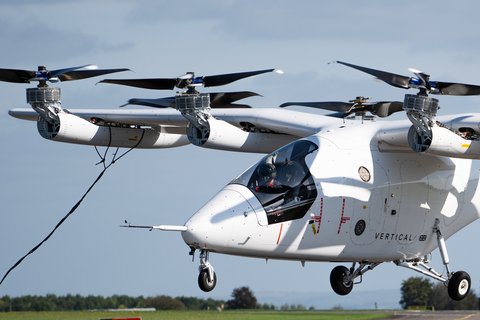- Phase 1 included tethered flights, ground taxi testing and high-powered ground runs, all with a pilot on board.
- Vertical is now preparing to progress to piloted untethered thrustborne testing, as soon as it receives permission from the UK Civil Aviation Authority (CAA).
- The VX4 went from its first powered ground test to 'wheels up’ in just one week – three times faster than the previous prototype.
Vertical Aerospace (Vertical) [NYSE: EVTL], a global aerospace and technology company pioneering zero-emissions aviation, has achieved another significant milestone. Its latest VX4 has completed the first phase of its piloted flight test programme at the Vertical Flight Test Centre.
This press release features multimedia. View the full release here: https://www.businesswire.com/news/home/20240912188188/en/

Vertical's Chief Test Pilot flys the latest VX4 prototype during phase one of its flight test programme in September. (Photo: Buiness Wire)
During Phase 1, the VX4 prototype conducted multiple piloted tethered flights and ground runs, across 20 piloted test sorties, completing a total of 70 individual test points. Together, these tests simulated various aspects of flight and operational situations needed to validate the prototype’s safety in real-world flight scenarios, including those outside of its expected operating conditions. By intentionally testing the aircraft's ability to handle failures, Vertical demonstrated the underlying safety of its design.
One of the most important tests successfully carried out included simulating the failure of one Electric Propulsion Unit (EPU) – inoperative testing – while in piloted tethered flight, to ensure the aircraft responds correctly and continues to be safe while in flight conditions.
These tests have enabled Vertical engineers to collect and measure 35,000 flight and system parameters and verify that all systems are operating correctly and safely in different conditions ahead of further expanding the flight test envelope to piloted thrustborne flight.
Alongside Phase 1 testing, Vertical’s engineers also completed more advanced low and high-speed taxi tests, including deliberately failing EPUs at high taxi speeds to confirm controllability and safety. This verified ground handling characteristics throughout the taxi envelope, as well as aerodynamic characteristics for increasing speed, while in a safe, ground test environment.
Vertical is continuing to work closely with the UK Civil Aviation Authority (CAA) on expanding its Permit to Fly as it prepares for Phase 2 of testing which will see the VX4 prototype undergo piloted thrustborne flight tests.
Vertical is currently developing an identical full-scale prototype which will accelerate the VX4’s flight test programme and demonstration capability. The company will take flight test learnings from both prototypes into the design and development of the certified VX4 model.
CEO of Vertical Aerospace, Stuart Simpson, said:
“It took us just one week to go from our first ground test to our chief test pilot flying the VX4, and we have been making outstanding progress since then. We continue to prove the safety and performance of our design and technology, which we believe to be market leading. Completing this first phase of testing is a significant feat for any eVTOL company and shows the strength of our aircraft, team, and our partners as we progress through our flight test programme and head towards our goal of creating a better way to travel.”
Phase 1 of testing included:
- Piloted tethered flight: performed using closed loop flight control to ensure the aircraft's stability and safety in a controlled environment. Also included simulated failure testing to validate one EPU deliberately failing and assessing automatic aircraft response to bring other engines to maximum power output while in tethered flight.
- Ground vibration testing (GVT): Working with specialists from world leading ATA Engineering – who performed GVT testing on the $10 billion James Webb telescope - eight heavy duty shakers were installed on the VX4 while it was suspended in the air to stress test the aircraft in different situations when flying, such as turbulence. 350 accelerometers - devices that measure the aircraft’s movements and vibrations during testing - were installed on the inside and outside of the aircraft to collect the data.
- Powertrain testing: Understanding how the powertrain is operating and evaluating all the components that generate and deliver power to the propellors. This includes a High Voltage (HV) ripple test to measure and analyse voltage fluctuations (ripple) generated on the powertrain and ensuring the battery can handle it, even at low charge, while providing a stable power supply. This is carried out while the aircraft is tethered in hover.
- Dynamic testing: Ensuring all systems are functioning correctly before they are put into use in flight in real-life conditions – such as powering up, checking the parts are installed and connected correctly and the systems and components work.
- Propellor testing: Propeller balancing and spinning tests to measure weight distribution of each propeller blade to ensure vibrations are minimised for smooth, stable flying.
- Taxi testing: VX4 is piloted at low and high speeds on the ground to test the aircraft can move forwards and backwards effectively, testing brake performance and direction of control using differential thrust.
Notes to Editors
Piloted flight test programme explainer:
- Phase 1: Tethered: the VX4 will perform stabilised hover while loosely tethered to the ground - COMPLETE
- Phase 2: Thrustborne: the VX4 will take-off and land vertically and conduct low speed flight manoeuvres with lift generated by the propellers.
- Phase 3: Wingborne: the VX4 will take-off, fly and land like a conventional aircraft, with lift generated by the wing.
- Phase 4: Transition: The VX4 will transition between thrustborne and wingborne flight, and vice versa.
New VX4 prototype
This next-generation VX4 is more powerful than the previous full-scale prototype, with an impressive 20% increase in the power to weight ratio, enabling the aircraft to reach speeds of up to 150mph – the certification aircraft’s intended cruise speed.
The aircraft has been designed and built alongside global aerospace partners, including GKN Aerospace, Honeywell, Hanwha, Molicel, Leonardo and Syensqo. It features Vertical’s next generation propellers and new proprietary battery technology, capable of delivering 1.4 MW of peak power and which has been designed and built at the state-of-the-art Vertical Energy Centre near Bristol, the UK’s most advanced aerospace battery facility.
About Vertical Aerospace
Vertical Aerospace is a global aerospace and technology company pioneering electric aviation. Vertical is creating a safer, cleaner and quieter way to travel. Vertical’s VX4 is a piloted, four passenger, Electric Vertical Take-Off and Landing (eVTOL) aircraft, with zero operating emissions. Vertical combines partnering with leading aerospace companies, including GKN, Honeywell and Leonardo, with developing its own proprietary battery and propeller technology to develop the world’s most advanced and safest eVTOL.
Vertical has 1,500 pre-orders of the VX4 worth $6bn, with customers across four continents, including Virgin Atlantic, American Airlines, Japan Airlines, GOL and Bristow.
Headquartered in Bristol, the epicentre of the UK’s aerospace industry, Vertical was founded in 2016 by Stephen Fitzpatrick, founder of the OVO Group, Europe’s largest independent energy retailer. Vertical’s experienced leadership team comes from top tier automotive and aerospace companies such as Rolls-Royce, Airbus, GM and Leonardo. Together they have previously certified and supported over 30 different civil and military aircraft and propulsion systems.
Forward-Looking Statements
This press release contains forward-looking statements within the meaning of the U.S. Private Securities Litigation Reform Act of 1995 that relate to our current expectations and views of future events. We intend such forward-looking statements to be covered by the safe harbour provisions for forward-looking statements contained in Section 27A of the Securities Act and Section 21E of the Exchange Act. Any express or implied statements contained in this press release that are not statements of historical fact may be deemed to be forward-looking statements, including, without limitation, statements regarding the design and manufacture of the VX4, the features and capabilities of the VX4, business strategy and plans and objectives of management for future operations, including the building and testing of our prototype aircrafts on timelines projected, including completion of the piloted test programme phases, selection of suppliers, certification and the commercialization of the VX4 and our ability to achieve regulatory certification of our aircraft product with any of our intended regulators on any particular timeline or at all, our ability and plans to raise additional capital to fund our operations, the differential strategy compared to our peer group, expectations surrounding pre-orders and commitments, our future results of operations and financial position and expected financial performance and operational performance, liquidity, growth and profitability strategies, our plans to mitigate the risk that we are unable to continue as a going concern, our plans for capital expenditures, as well as statements that include the words “expect,” “intend,” “plan,” “believe,” “project,” “forecast,” “estimate,” “may,” “should,” “anticipate,” “will,” “aim,” “potential,” “continue,” “are likely to” and similar statements of a future or forward-looking nature. Forward-looking statements are neither promises nor guarantees, but involve known and unknown risks and uncertainties that could cause actual results to differ materially from those projected, including, without limitation: our limited operating history without manufactured non-prototype aircraft or completed eVTOL aircraft customer order; our history of losses and the expectation to incur significant expenses and continuing losses for the foreseeable future; the market for eVTOL aircraft being in a relatively early stage; our potential inability to produce, certify or launch aircraft in the volumes or timelines projected; the potential inability to obtain the necessary certifications for production and operation within any projected timeline, or at all; any accidents or incidents involving eVTOL aircraft could harm our business; our dependence on partners and suppliers for the components in our aircraft and for operational needs; the potential that certain strategic partnerships may not materialize into long-term partnership arrangements; all of the preorders received are conditional and may be terminated at any time and any pre-delivery payments may be fully refundable upon certain specified dates; any circumstances; the inability for our aircraft to perform at the level we expect and may have potential defects; any potential failure to effectively manage our growth; our inability to recruit and retain senior management and other highly skilled personnel, our ability to raise additional funds when we need or want them, or at all, to fund our operations; our limited cash and cash equivalents and recurring losses from our operations raise significant doubt (or raise substantial doubt as contemplated by PCAOB standards) regarding our ability to continue as a going concern; and the other important factors discussed under the caption “Risk Factors” in our Annual Report on Form 20-F filed with the U.S. Securities and Exchange Commission (“SEC”) on March 14, 2024, as such factors may be updated from time to time in our other filings with the SEC. Any forward-looking statements contained in this press release speak only as of the date hereof and accordingly undue reliance should not be placed on such statements. We disclaim any obligation or undertaking to update or revise any forward-looking statements contained in this press release, whether as a result of new information, future events or otherwise, other than to the extent required by applicable law.
View source version on businesswire.com: https://www.businesswire.com/news/home/20240912188188/en/
Contacts
Justin Bates, Head of Communications
justin.bates@vertical-aerospace.com
+44 7878 357 463






